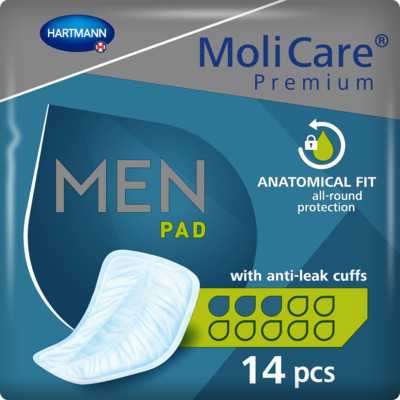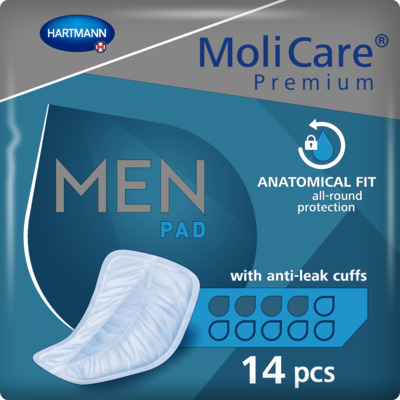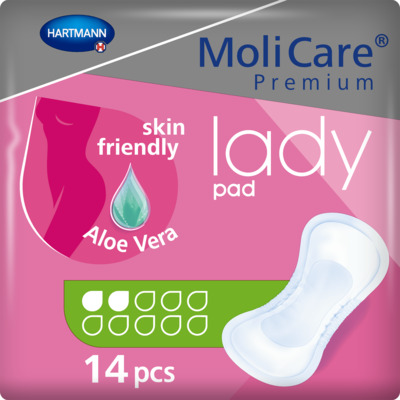Incontinence Advice
What You Need To Know About Incontinence Associated Dermatitis
For those who are either new or already knowledgeable about the skin, you may have come across the phrase ‘incontinence-associated dermatitis’ or IAD. But what exactly is this condition, and how can it affect incontinence as a whole? This article will answer these questions, so that you may gain a better understanding of the condition, so that you can prepare yourself on how this may affect incontinence, and how to manage the condition.

Incontinence-Associated Dermatitis
Incontinence-associated dermatitis is a skin irritation caused by urine and faeces contacting the skin. It occurs in people who experience urinary or faecal incontinence, or both at the same time (dual or double incontinence).
Who can get Incontinence-Associated Dermatitis
Incontinence-associated dermatitis can occur in people who experience different types or levels of incontinence. IAD can be found in around 5.6% to 50% of cases, with occurrence rates ranging from 3.4% to 25% across different situations and groups. Around a third of people experiencing faecal incontinence commonly encounter incontinence-associated dermatitis.
Causes of Incontinence-Associated Dermatitis
Incontinence-associated dermatitis can be caused by the incorrect mixture of chemical and physical skin irritation. The contact of urine and faeces can affect and increase skin pH, which weakens the skin barrier and heightens infection risk. Friction contributes to physical irritation, further weakening the skin's defences. Using MoliCare® skin barrier cream can lessen these effects and aid in keeping the skin fresh.
Clinical Features of Incontinence-Associated Dermatitis
In incontinence-associated dermatitis, noticeable signs include redness and swelling on genital and anal skin's curved parts, sometimes leading to blisters (bullae) and erosions. Depending on positioning, the rash's distribution can be symmetrical or asymmetrical.
During the acute phase, surrounding skin might appear wet and softened, while in the chronic phase, it could display dryness and peeling. Dermatitis might extend to skin folds or even areas not in direct contact with urine and faeces, although these regions typically experience milder effects.
Incontinence Associated Dermatitis (IAD)
- Sources
- Incontinence Associated Dermatitis
- Who can get Incontinence-Associated Dermatitis
- Severity of Incontinence Associated Dermatitis
- How To Get Diagnosed For Incontinence Associated Dermatitis
- How To Treat Incontinence Associated Dermatitis
- What to Expect from Incontinence Associated Dermatitis
- Risk Factors and Preventative Measures
- Being Aware of IAD
- FAQs
What Could Happen Due To Incontinence-Associated Dermatitis
Incontinence-associated dermatitis can lead to notable irritation and discomfort, affecting both the person experiencing it and those providing care.
Skin infections, often caused by Candida albicans and Staphylococcus aureus, become more likely. In some cases, incontinence-associated dermatitis can even result in pressure ulcers of varying depths.

Severity of Incontinence Associated Dermatitis
Symptom intensity depends on factors like the overall health of the skin, health and nutrition, and exposure to allergens. Those prone to leakage or accidents due to their specific incontinence condition might experience more severe IAD, as they have more frequent exposure to urine and faeces.
How To Get Diagnosed For Incontinence Associated Dermatitis
Diagnosing incontinence-associated dermatitis involves a few steps:
- Visual Examination: Your GP can examine the affected skin. They'll look for redness, inflammation, and any other visible signs of irritation
- Medical History: The doctor might ask about your symptoms, how long they've been present, and your history of incontinence.
- Skin pH Test: In some cases, a pH test might be performed on the affected area. Increased pH levels can indicate the presence of incontinence-associated dermatitis.
- Exclusion of Other Conditions: Sometimes, similar skin conditions might need to be ruled out. This could involve tests or assessments to differentiate between different skin issues.
- Microbial Testing: If there's suspicion of infection, swabs might be taken from the affected area for laboratory testing to identify any present microorganisms.
How To Treat Incontinence Associated Dermatitis
You can help prevent and treat incontinence-associated dermatitis by following a good skin cleansing and care routine, using appropriate skin cleansers, and using barrier creams.
Manage incontinence by using appropriate methods. Consider:
- Maintaining regular toileting routines.
- Using appropriate absorbent pads or panties, changed when needed.
- Intermittent or indwelling urinary catheters.
- Systems like rectal catheters or anal bags for faecal management.
To treat incontinence-associated dermatitis:
- Safeguard skin from further urine and faeces exposure.
- Create a healing environment.
- Address any accompanying infections.
For confirmed bacterial and fungal infections, antibiotics and antifungal agents are recommended.

What to Expect from Incontinence Associated Dermatitis
Managing existing incontinence-associated dermatitis can be challenging and tends to reappear. Effective skin care and addressing incontinence, along with related infections or pressure sores, can lead to the clearance of the dermatitis or a reduction in its intensity.
Risk Factors and Preventative Measures
Risk Factors
Certain factors increase the likelihood of developing IAD:
- Immobility or limited movement.
- Being bedridden or using a wheelchair.
- Impaired cognitive ability that prevents recognizing or communicating discomfort.
- Specific medical conditions that cause urinary or faecal incontinence, such as neurological disorders.
Preventive Measures
Preventing IAD involves a multi-faceted approach:
- Choosing fast-absorbing incontinence products.
- Keeping the skin clean and dry.
- Using pH-balanced skin cleansers.
- Applying skin protectants or barrier creams.
- Ensuring timely changes of incontinence products to prevent prolonged exposure.
Proper Skin Care
IAD's impact can be minimised with meticulous skin care practices such as the following:
- Gently cleanse the affected area using mild, non-irritating cleansers.
- Pat the skin dry instead of rubbing it.
- Avoid products with alcohol, fragrance, or strong chemicals that can worsen irritation.
- Use moisturisers to keep the skin hydrated and supple.
- Utilise barrier creams to create a protective layer between the skin and urine/faeces.
Choosing Incontinence Products:
Selecting the right absorbent products is crucial:
- Speak to a healthcare professional about the appropriate level of absorbency.
- Choose products with features that minimise moisture exposure, such as fast absorbing, 3-layer absorbent core, skin pH balanced products.
- Ensure a proper fit to prevent leaks and friction.
Promoting Skin Healing
For established IAD cases, creating an environment conducive to healing is essential:
- Keep the skin clean and dry to prevent infection.
- Use prescribed creams to support healing.
- Address any secondary infections promptly with prescribed antibiotics or antifungal medications.
Being Aware of IAD
Incontinence-associated dermatitis can pose different and unique challenges to anyone who comes across it and can affect comfort and well-being. Understanding its causes, symptoms, and management options in this article can aid in helping people deal with the condition. While treating established cases can be complex and recurring, diligent skin care, incontinence management, and infection control stand as crucial strategies. If conditions lessen or worsen, be sure to keep your GP informed throughout. For more information, our dedicated team at HARTMANN UK is always on hand to help too, and can recommend incontinence products that can aid your experiences with IAD.
Order Your Incontinence Products Now
FAQs
What causes incontinence-associated dermatitis?
IAD is primarily caused by the prolonged exposure of the skin to urine or faeces, which can lead to irritation, maceration (softening of the skin), and breakdown of the skin's natural protective barrier. Friction, pressure, and the presence of enzymes in urine and faeces further contribute to its development.
What are the symptoms of incontinence-associated dermatitis?
Common symptoms of IAD include redness, irritation, swelling, tenderness, and sometimes open sores or blisters on the affected skin. The skin may feel warm to the touch and may become painful if not managed promptly.
How is incontinence-associated dermatitis diagnosed?
Diagnosis is usually based on a visual examination of the affected area by a GP. In some cases, they may perform tests to rule out other possible skin conditions that may have similar symptoms.
Sources
Cleveland Clinic (n.d.) Candida Albicans. [online] Available at: https://my.clevelandclinic.org/health/diseases/22961-candida-albicans [accessed 17/08/23]
Taylor, T.A., Unakal, C.G., (2022) Staphylococcus aureus Infection. [online]. Treasure Island (FL): StatPearls Publishing. Available from: https://www.ncbi.nlm.nih.gov/books/NBK441868/ [accessed 17/08/23]

MoliCare® Premium Men Pad 3 Drops
<h2>Suitable for men with bladder weakness</h2> <p>Suitable for men of all age groups, body shapes and sizes, it truly is a one size fits all with this range. It is never pleasant to go about daily activities with the potential risk of an incontinence slip, MoliCare® have created the Premium Men Pad 3 drops, designed with a V-Shape to comfortably fit around the desired area, and has a textile-like back sheet for extra protection.</p> <p>To make sure that you choose a premium men pad that is right for you, check out the additional features of this product range:</p> <h2>Leakage protection for men you can rely on</h2> <p>With a body-shaped design, these absorbent mens pads offer reliable protection for men with light bladder weakness. The soft, cotton-like materials ensure discreet comfort, and the odour neutraliser keeps you feeling fresh and confident.</p> <h2>Secure fit and skin-friendly</h2> <p>The Premium MEN Pads feature a wide adhesive strip for secure fixation in your regular underwear, providing you with peace of mind during your daily activities. The soft and breathable materials are gentle on your skin, maintaining its health with a skin-friendly pH.</p> <h2>All-round protection for men</h2> <p>MoliCare® Premium MEN Pads are equipped with a quick dry system, anti-leakage system, and cuffs for added security, ensuring all-round protection you can trust. Dermatologically tested, these pads are safe and reliable for daily use.</p> <h2>Tailored for your needs</h2> <p>Available in different absorbency levels, MoliCare® incontinence products for men cater to varying degrees of incontinence, providing you with the level of care that suits your needs. MoliCare® Premium MEN Pads are perfect for daily wear or when you need extra protection against slight to moderate incontinence. Discreet and comfortable, they enable you to maintain your active lifestyle with confidence.</p> <h2>Fast and reliable delivery</h2> <p>Our quick ordering service makes it easy to get the incontinence products you need. Additionally, our price match promise ensures you get both quality and value for money.</p> <p>Enjoy fast delivery on all orders over £50 when you purchase from HARTMANN Direct.</p>
MoliCare® Premium Men Pad 4 Drops
<h2>Comfortable and absorbent</h2> <p>Why MoliCare for men? Hers are some of the key features of the MoliCare® Premium Men Pads from Hartmann:</p> <ul> <li>Discreet and comfortable</li> <li>Fits the male physique</li> <li>3-layer absorbent core</li> <li>Fast-absorbing system</li> <li>Anti-leakage cuffs</li> <li>Odour neutralisers</li> <li>Wide adhesive strip</li> <li>Skin-friendly</li> </ul> <p>With an affordable price and great quality guarantee, you cannot regret choosing MoliCare® Premium Men Pad 4 drops, equipped with anti-leak cuffs, and 14 pieces per bag.</p> <h2>Slim and discreet under clothing</h2> <p>MoliCare® Premium MEN Pads offer reliable support for men dealing with bladder weakness. Whether it's stress incontinence or urge incontinence, these pads for men are designed to provide a discreet and quick solution on the go. Simply place the pad before applying your underwear and secure it with the adhesive strip for worry-free protection. MoliCare® Premium MEN Pads offer full coverage for men facing very light to moderate bladder weakness.</p> <h2>Leakage protection for men</h2> <p>MoliCare® understands that each individual's incontinence needs are unique. That's why our incontinence products, including MoliCare® Premium MEN Pads, are available in different absorbency levels. You can find the perfect fit and protection for your specific requirements.</p> <h2>Reliable and soft on the skin</h2> <p>Our body-shaped absorbent pads are designed to deliver dependable and skin-friendly incontinence protection every day. Experience discreet comfort with the soft, cotton-like materials and the added benefit of an odour neutraliser, ensuring you feel fresh and confident throughout the day.</p> <h2>Fast delivery to your home</h2> <p>At HARTMANN Direct, we ensure a fast delivery service for all our products. Enjoy free delivery on orders over £50, making it convenient and hassle-free to receive the incontinence products you need. Our dedicated customer care team is here to discuss your incontinence product needs and answer any questions you may have. Call us today on 0800 028 9470 to experience the comfort and confidence that MoliCare® Premium MEN Pads can provide.</p>
MoliCare® Premium Lady Pad 2 Drops
<h2>Skin Friendly Pant Liners</h2> <p>For women that experience slight incontinence and bladder weakness, across different age groups, it can be a challenge to find the right bladder weakness product that is easy to apply and wear without the worry of potential leakages. Fortunately, we understand this approach, hence why we are happy to offer our MoliCare® Premium Lady Pad 2 drops, that is skin-friendly, Aloe Vera applied, and comes with 14 liners per bag.</p> <h2>Slim and discreet liners</h2> <p>Whether dealing with stress incontinence or urge incontinence, these panty liners offer a discreet and easy solution on the go. Simply place the pad in your underwear and secure it with the adhesive strip for all-round protection. Available in different absorbency levels, MoliCare® bladder weakness products cater to all levels of bladder weakness, ensuring secure care.</p> <h2>Control Bladder Weakness</h2> <p>Enjoy the benefits of these body-shaped absorbent panty liners, designed for women with bladder weakness. The pads offer discreet, reliable protection with features including odour control and fast absorption.</p> <p>With a wide adhesive strip, you can comfortably fix the pad in your regular underwear, providing secure and comfortable fixation. The pads are skin-friendly, featuring soft, breathable materials, including foam cuffs, and a top sheet treated with Aloe Vera.</p> <p>Keeping your skin healthy is a priority, which is why MoliCare® Premium Lady Pads have a skin-neutral pH value of 5.5 and an antibacterial finish. They are also dermatologically tested, offering peace of mind.</p> <h2>Buy pant liners online</h2> <p>Never worry about running out with our convenient order service and fast delivery direct to your door. Enjoy free shipping on orders over £50.</p> <p>If you need assistance, our professional customer service team is here to support you in choosing the right product. Reach out to us today at 0800 028 9470 and experience the comfort and reliability of MoliCare® Premium Lady Pads.</p>
